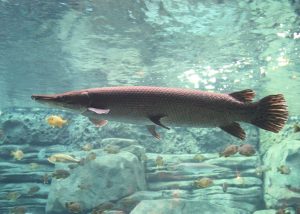Alligator gar reintroduction will improve Illinois waterways
Illinois News Network — August 9, 2016
The alligator gar can grow up to eight feet long and can weigh up to 300 pounds. (Photo by Greg Hume)
A program to restock Illinois waterways with the once abundant alligator gar has more to do with improving habitat and sport-fishing opportunities than getting rid of the Asian Carp.
And it won’t cost taxpayers an extra dime, Dan Stephenson, chief of fisheries at the Illinois Department of Natural Resources, said.
“Probably the most important thing we’re trying to do is bring back an extirpated species,” he said. “Extirpated means they’re not here any longer. They’re not (entirely) extinct, they’re found in good numbers down in Louisiana and Texas. But they aren’t found in Illinois anymore.”
They used to be, and in pretty fair numbers. But nobody in Illinois liked them much, and hadn’t for a very long time.
The alligator gar is tough skinned and doesn’t have a lot of meat for eating, and its two rows of razor-sharp teeth make taking one off the hook problematic. Plus, they can grow up to eight feet long and can weigh up to 300 pounds.
But it is a top-tier predator, which Stephenson said is why many state residents have gotten the mistaken impression that setting them loose on the invasive Asian carp is the primary reason for the alligator gar’s release.
That may happen to some degree, but he said the main reason for the reintroduction of the alligator gar is to improve the state’s waterway diversity — and to create a fishery that could be used to improve the state’s sport-fishing standing.
“They’re an apex predator and they’re at the very top of the food chain, and they add to the biodiversity of the fish population, so that’s the second reason (for the program),” he said. “And the third reason is to make a giant fishery.”
He said the program will not cost taxpayers any additional money
“The Division of Fisheries is funded exclusively by the sale of fishing licenses, or almost exclusively,” Stephenson said. “There’s another small tax on the license plate registration that went through a couple of years ago. That provides a little bit of money, but the vast majority of the money just comes from fishing license sales.”
He said using that money means that those most invested in the biodiversity of the Illinois fish population will gain the most from it.
“The fishermen are paying for the restocking of the alligator gar and any other fisheries work we do in the state – any other hatchery work or the stocking of the muskies, or the walleye or the bass, or whatever,” he said. “And the fish management work that we do throughout the state is all paid for by the fishermen.”
—
Alligator gar reintroduction will improve Illinois waterways —







